How To Stencil on Wood (Ultimate Guide & Video, 2025)
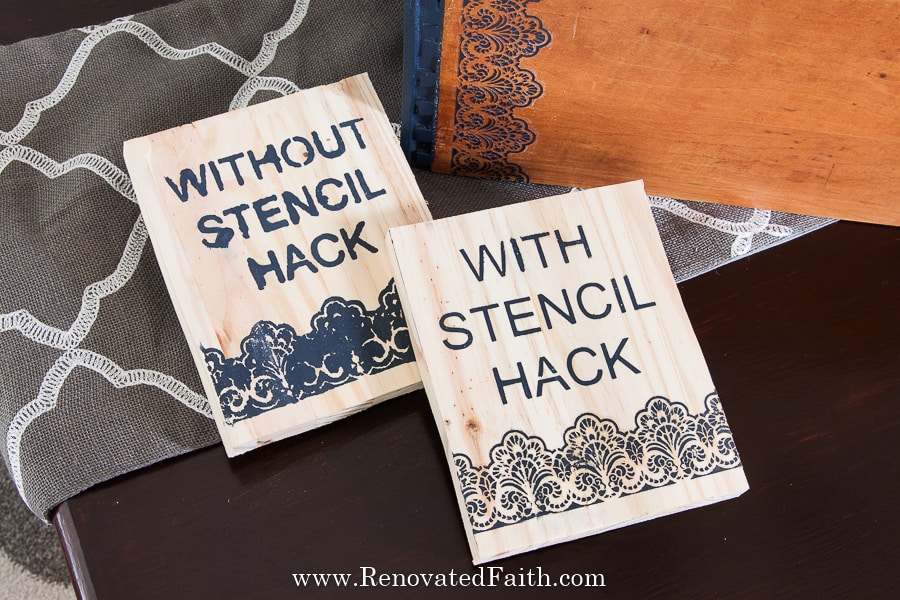
How Do You Stencil on Wood Without Bleeding?
Stenciling wood without bleedthrough is easy with a few simple hacks! In this post, I show you how to stencil on wood perfectly every time.
Imagine yourself sitting down in front of your favorite Netflix series on a Saturday afternoon for some craft time. You plan on adding a stencil to a stained family antique or even a sign made of reclaimed wood.
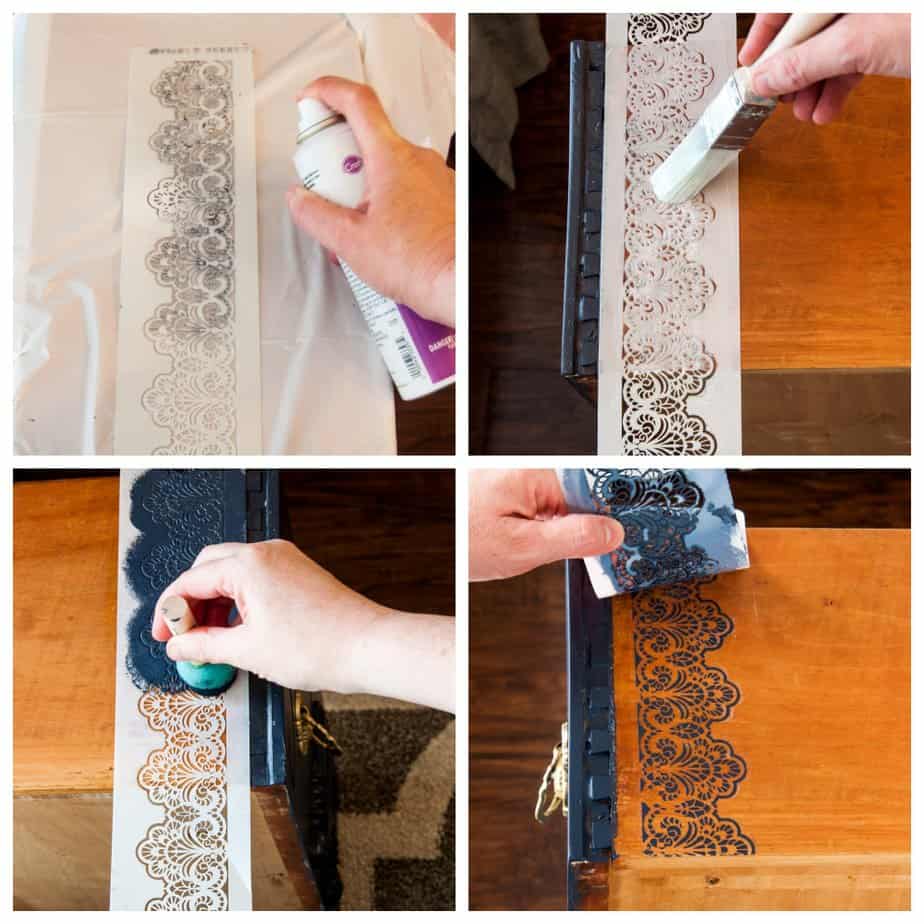
But after you paint over the entire stencil and pull it up, you finally realize the paint bled underneath the stencil and now you have to start all over again!
After LOTS of experimenting, I found the best way to ensure the paint doesn’t bleed through your stencil, giving you great results on any project!
With these simple tips, you can use even the most detailed laser stencils without frustrated bleedthrough.
LET ME SHOW YOU:
- How to stencil on uneven surfaces like Barnwood
- The best paint to use for stenciling on wood
- How to keep stencils from bleeding on wood signs
- Why you don’t need to get your act together before seeking the Lord (Check out the Renovate Your Faith Devotional at the end of this post!)
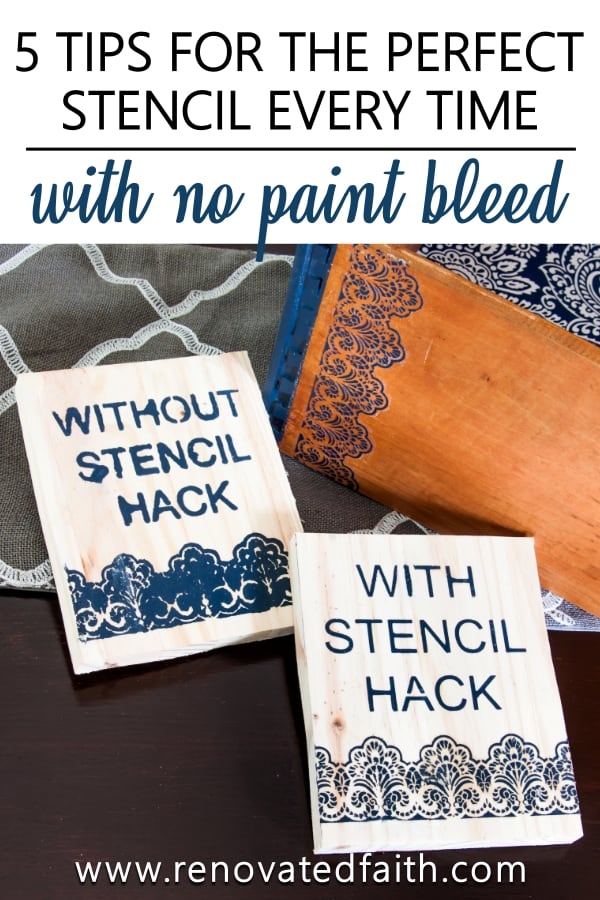
Quick Links to Information in this Post
- 1 How Do You Stencil on Wood Without Bleeding?
- 2 How to Stencil on Wood without Bleeding
- 3 How to Stencil on Wood Furniture without Bleeding – Craft Supplies:
- 4 How to Stencil on Wood Without Bleeding – The Process:
- 5 Renovated Faith: What’s in a Name?
- 6 The Best Way to Paint With Stencils
- 7 FAQ: How Do You Get Clean Lines with Stenciling on Wood?
- 8 Final Thoughts – What is the Best Way to Stencil on Wood?
- 9 How to Stencil on Wood, YouTube Video:
- 10 How to Stencil on Wood Without BLeeding

How to Stencil on Wood without Bleeding
On my grandmother’s old dresser (see the full reveal below), I decided that I wanted to stencil lace onto the side of every drawer.
My grandma, Cornelia Mosely, was a seamstress and as I mention in the video, I specifically remember her sewing fancy lace on the hems of dresses. I even have a container of some of her old lace as a keepsake.
Because of this special memory, I wanted to add a lace stencil on each drawer of her old dresser.
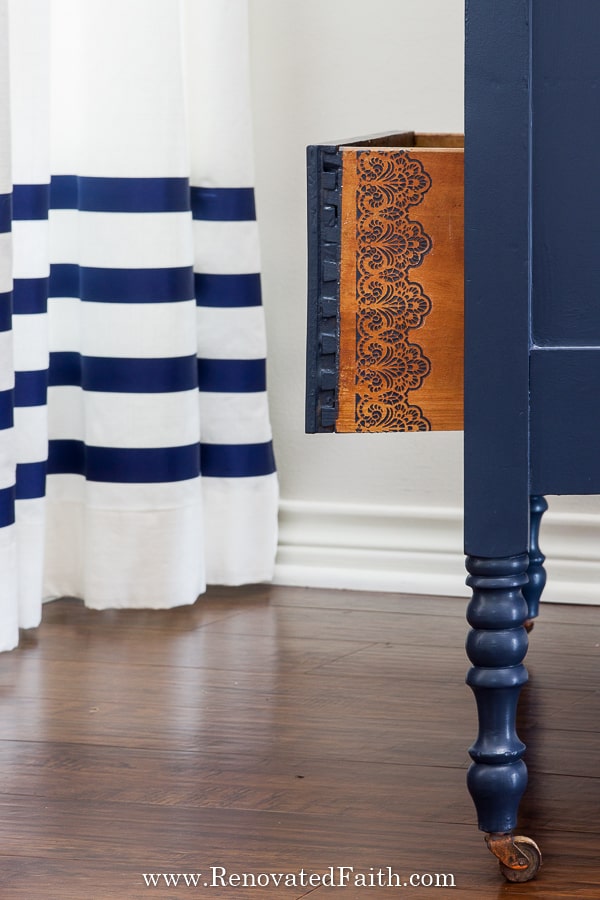
Can You Stencil Over Stained Wood?
Adding a stencil to stained wood is not an easy feat. For one thing, you can’t touch up mistakes with paint as you could on a painted piece of furniture or sign.
The wood on the sides of the drawers was pretty old and had minor water damage making it uneven and cracked in spots. I wanted to leave the sides of the drawers in their original state so that would mean I had to get the stencil right the first time, without any paint bleed.
What made this process a little more difficult was the fact that the stencil I chose was SO DETAILED. I think I probably picked the most ornate laser stencil in existence.
Detailed laser stencils are more prone to bleedthrough, unfortunately, but fortunately, there are some easy stencil hacks to help you get great results on your next paint project!
The Best Way to Stencil on Wood
Because I tend to overdo things, I did a lot of experimenting with every stencil hack I could find. Then, when I discovered the ones that worked best, I found out which ones worked well in combination for a perfect stencil every time. I have no doubt that you will have the same success with your own project!
How to Stencil on Wood Furniture without Bleeding – Craft Supplies:
Acrylic Paint or Latex Paint – The first thing you need is good paint – either latex or acrylic paint. (After I blind-tested and reviewed 24 furniture paints, I recommend Benjamin Moore Advance. You can see the full results for each paint brand here: The Absolute Best Paint for Furniture )
Stencils for Wood Furniture (Reusable) – I found the lace stencils I used on Amazon.
Repositionable Stencil Spray – I highly recommend using this stencil spray as others can gunk up your stencils permanently. Ask me how I know!
Mod Podge – You can use any sheen but the matte sheen is ideal.
Spouncer or Stencil brushes –
Clear-Coat for Wood (optional) – After testing several clear coats, this is my absolute favorite clear coat for furniture: Varathane Waterbased Polyurethane
Paper Towels and Paper Plates (to use as a paint tray)
Painter’s Tape (Optional)
Scraper Tool for Cleaning Your Stencil (Optional)
Cutting Mat (Optional)
FREE Must-Have Painting Tips for Furniture – Be sure to download my time-saving tips for painting furniture projects available in my free resource library. You can get them at the bottom of this post.
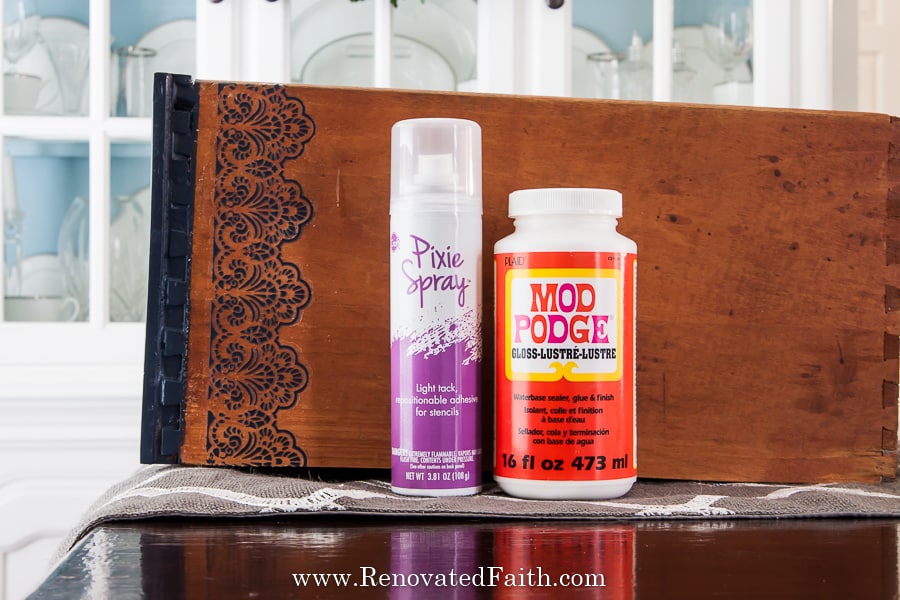
How to Stencil on Wood Without Bleeding – The Process:
Here is a full step-by-step video showing from start to finish. There is also a video tutorial that goes along with this post and if it doesn’t pop up you can access it and my other DIY videos here: How To Stencil on Wood, YouTube Video
Step 1: How to Stencil on Old Barn Wood – Surface Prep
Barn wood, pallet wood, and reclaimed wood are usually very uneven with prominent grain marks or cracks. This rustic look is great but it makes it really hard to stencil on uneven wood without the paint bleeding.
The first step is to prep the surface before you start painting to ensure as few uneven areas as possible when it is time to paint.
When to Sand before Stenciling on Wood (Optional)
If you are adding a stencil to a painted sign or painted furniture piece, be sure to sand before the first coat of paint. (This will also work for new raw wood but not stained wood).
Sanding will ensure the wood surface is already as even as possible and the paint can’t bleed through any cracks. Sanding is so easy and I would be lost without my electric stander. To find out how easy it is to sand signs and furniture, click here: How to Sand in Less Than 5 Minutes.
How TO Stencil on Rough Wood – Add a Clear Coat (Optional)
Whether you are working with furniture from a thrift store or a piece of barn wood, many of the hard surfaces you want to stencil will have deep wood grains.
For paint projects where you are worried about stencil bleed on rough wood, you can use a clear coat to prevent the new paint from seeping into those cracks.
Like the dresser drawers on my Grandma’s old dresser, I wanted to leave the sides in their completely natural state. So for that reason, I didn’t want to sand the sides of the drawers.
Instead, I brushed on my favorite clear coat (see why here) before stenciling for two reasons. For one thing, it will fill in uneven areas in the wood where paint could bleed through. Also, it seals the wood so that if I do have some bleedthrough, I can easily wipe it off of the clear-coated wood surface.
This step is totally optional but if you can’t sand, you can protect the wood while avoiding stencil bleed with this polyurethane: Varathane Water-Based Clear Coat
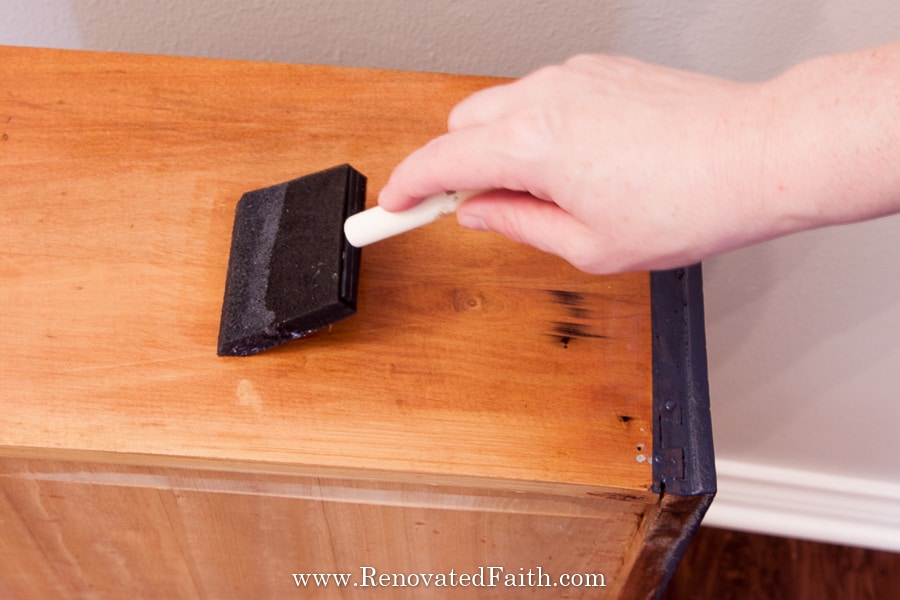
Renovated Faith: What’s in a Name?
God loves us too much to leave a project half-done…He continually works on each one of us, as a lavish expression of His amazing love and grace. DIY projects remind me of how God renovates our hearts. If you are a work-in-progress, just like I am, check out the Renovate Your Faith Devotional at the bottom of this post. Click here for a weekly reminder of new posts by email.
Step 2: How to Prevent Bleeding with Wood Signs & Furniture with Spray Adhesive
To temporarily attach your stencil to the wood surface, you want to use a spray adhesive. But not all spray adhesives are created equally.
Initially, I used one that worked great at first but when I reused my stencil, the spray gunked up my stencil and I couldn’t remove it even with mineral spirits.
So, using the right stencil adhesive will ensure that your stencil sticks to the surface and you can reuse the stencil over and over.
When you are ready to place your stencil on the wood, spray a light coat of spray onto the underside of the stencil keeping the can about 12 inches away. Be sure to spray your stencil over the sink or a trash bag as I do in the video.
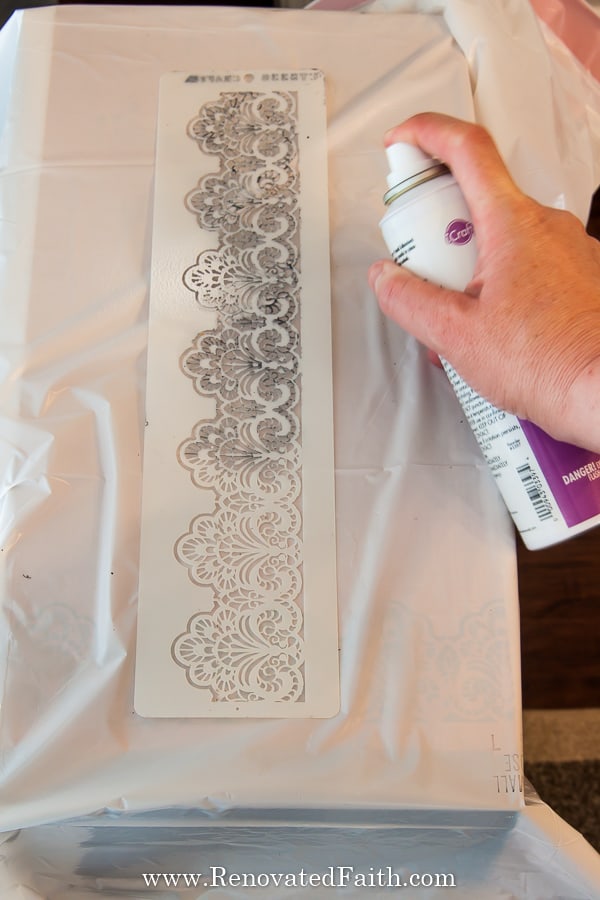
Step 3: Applying the Stencil on Wood or Furniture
For the next step, place the sprayed stencil on your wood surface. I like to press down in the middle and then wipe towards the outside of the stencil to make sure it is nice and flush so no paint can bleed underneath.
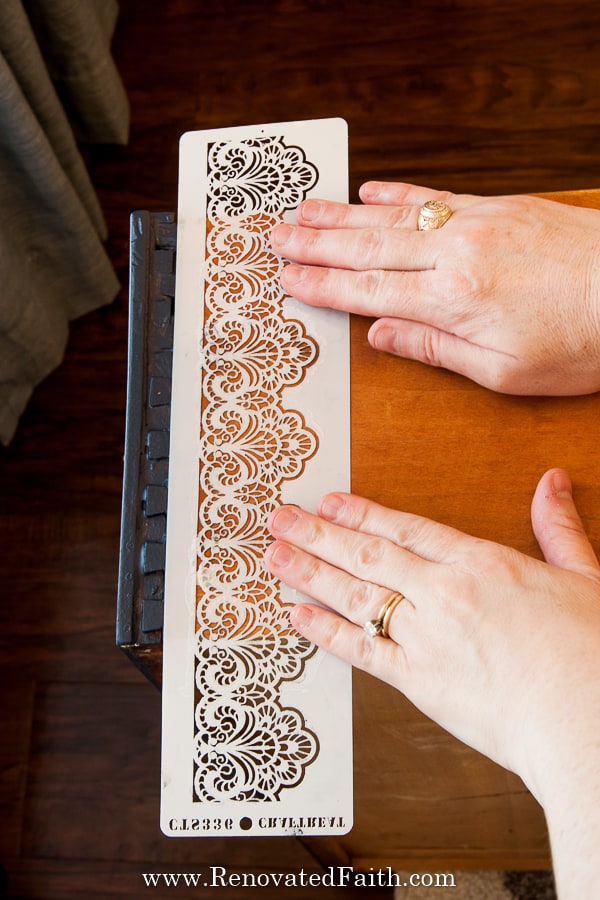
Step 4: How to Stencil on Wood with Mod Podge
The best way to stencil on wood always involves this important step using mod podge!
The mod podge creates a barrier between the edge of the stencil and the paint and since it dries completely clear you can’t see it. It keeps paint from seeping under the stencil and creates a crisp edge so you get the best results every time.
Use a brush to apply a thin layer of mod podge. You’ll notice in the video that I brush lightly but in all possible directions to get mod podge in any cracks and crevices that might be hiding under the stencil.
Let the mod podge layer dry for at least 40 minutes. You can also use a hair dryer to help it dry faster but honestly, I had better results letting the mod podge air dry. (This step also works well on stenciling curtains).
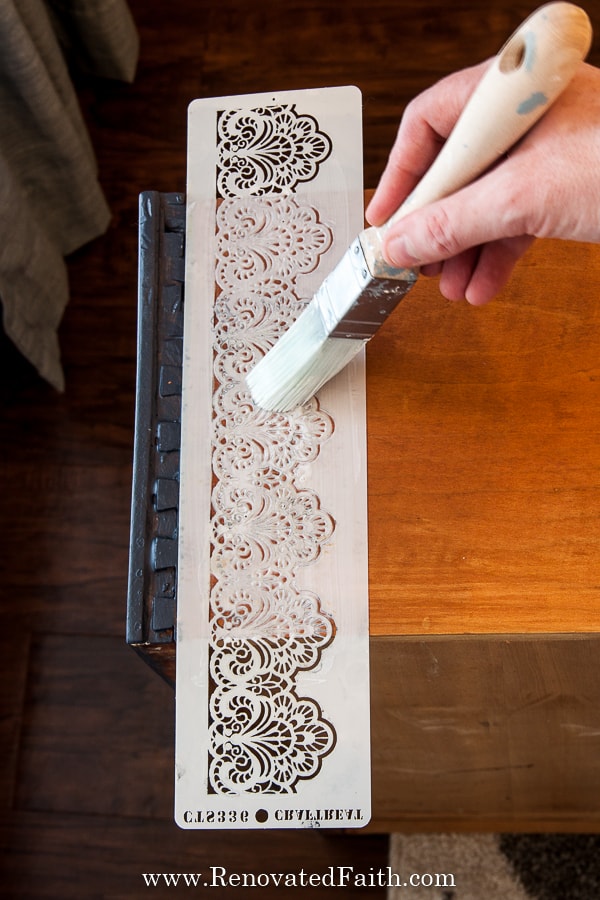
Step 5 – How To Paint With Stencils on Wood Using a Spouncer
What Kind of Paint Do You Use to Stencil On Wood?
There are several different paint options for stenciling. For my grandmother’s dresser, I used latex paint in Benjamin Moore Hale Navy because that’s what I used to paint the rest of the dresser and I wanted it to match exactly.
You can also use acrylic paint too as both work well.
As far as my favorite overall type of paint, I prefer Benjamin Moore Advance after testing over 24 brands of paint here: The Best Paint for Furniture (24 Paints Blind-Tested and Reviewed)
Benjamin Moore Advance comes in quart containers in their local stores and then sample sizes that you can buy online. This is a great option if you want to match a specific paint color. Also, this paint is great if you are looking for a super smooth finish without brush strokes.
How to Stencil on Wood with Latex Paint
Instead of a brush, be sure to use a spouncer for the paint. Dip the spouncer in paint and then wipe off the excess. You want to paint on a light coat by using up and down motions as I do in the video.
Keep adding a little paint at a time until all the stencil holes are painted. Make sure there isn’t extra paint just sitting on the surface.
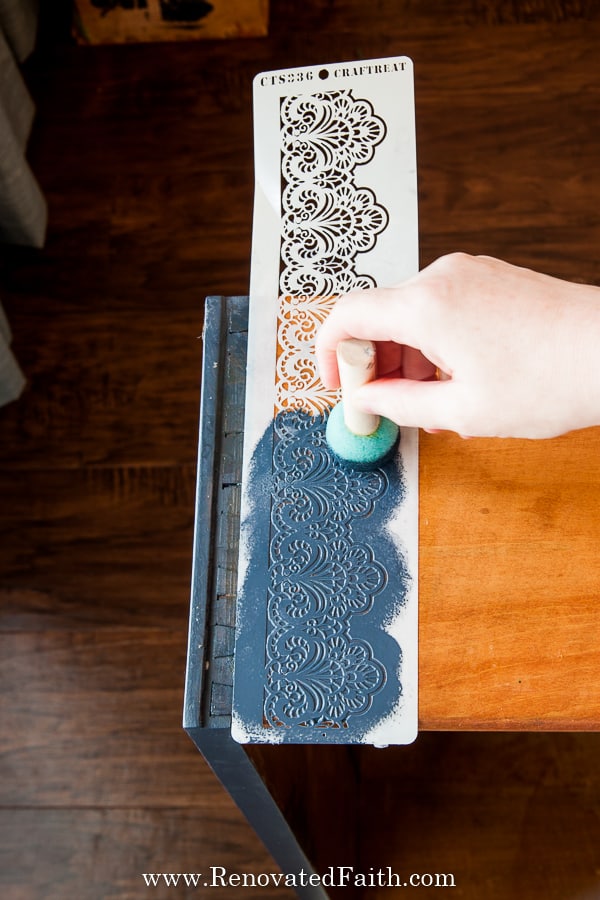
Do You Let Paint Dry Before Removing Stencil?
Now it’s time to remove the stencil and it’s best to do this before the paint dries. Carefully lift the stencil from one end to another.
Since the paint is still wet, it will be easy to fix any bleed-through, although you shouldn’t have any. Pulling up the stencil before the paint dries is also the best way to keep the paint from peeling with stencils.
If you have any white areas, that is just mod podge that has not dried. You can let it dry or dry it with a hairdryer to speed up the process.
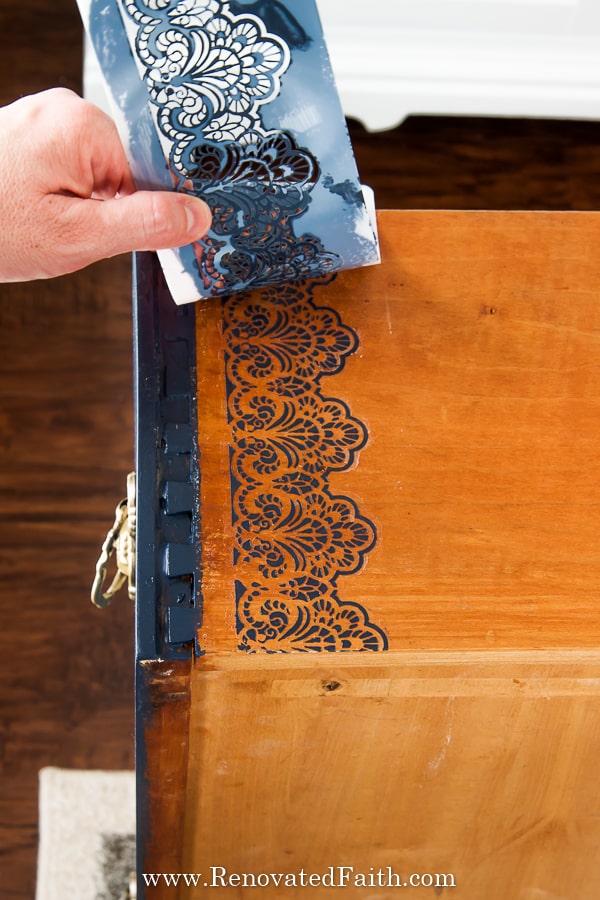
How to Fix Stencil Bleed on Wood
With this process, you shouldn’t have to fix stencil mistakes but if you do, they can easily be removed. Dip a q-tip in water and dab the area that has bled through. The wet paint should come right up!
Let the paint dry according to the instructions on the can or bottle.
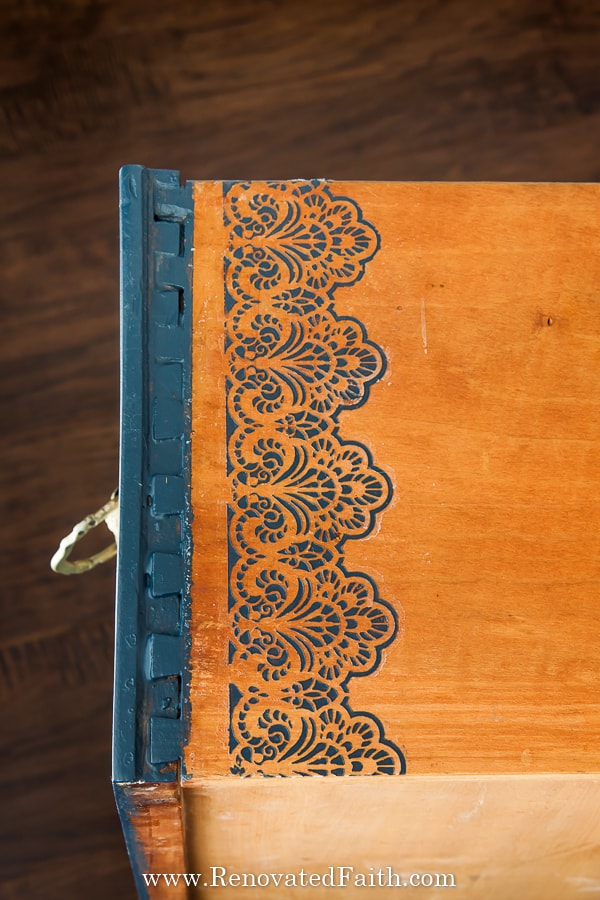
DON’T FORGET TO TAKE A PICTURE!
Now that you are done, I’d love to see how it turned out! ❤️ Post your before and after photos here!
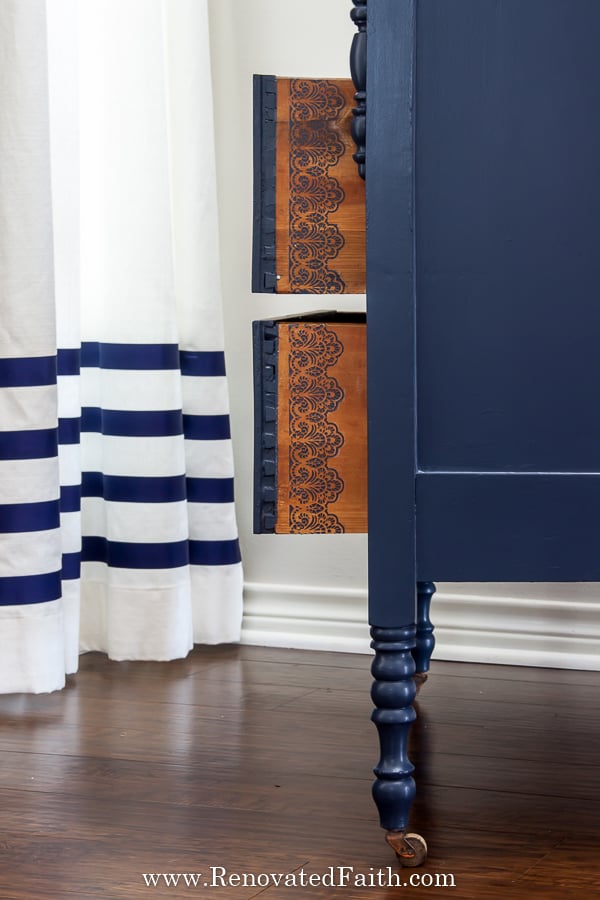
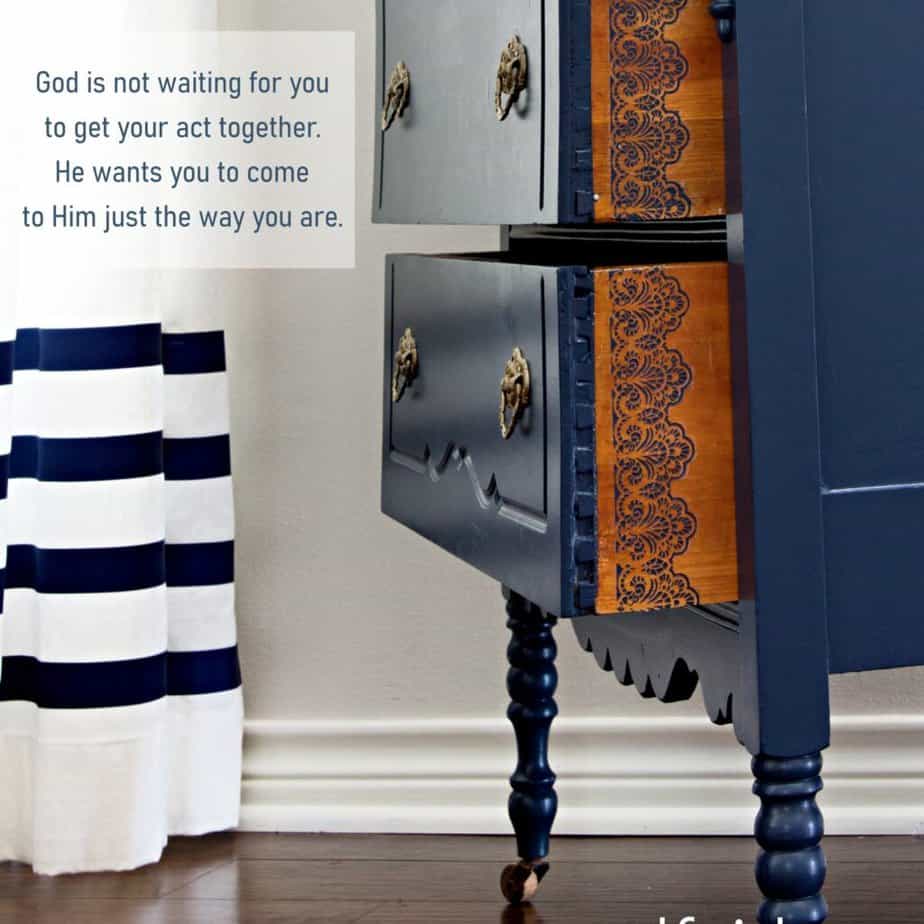
RENOVATE YOUR FAITH: God Delights in Your Details
For more spiritual encouragement, click here for the rest of my Renovate Your Faith Posts.

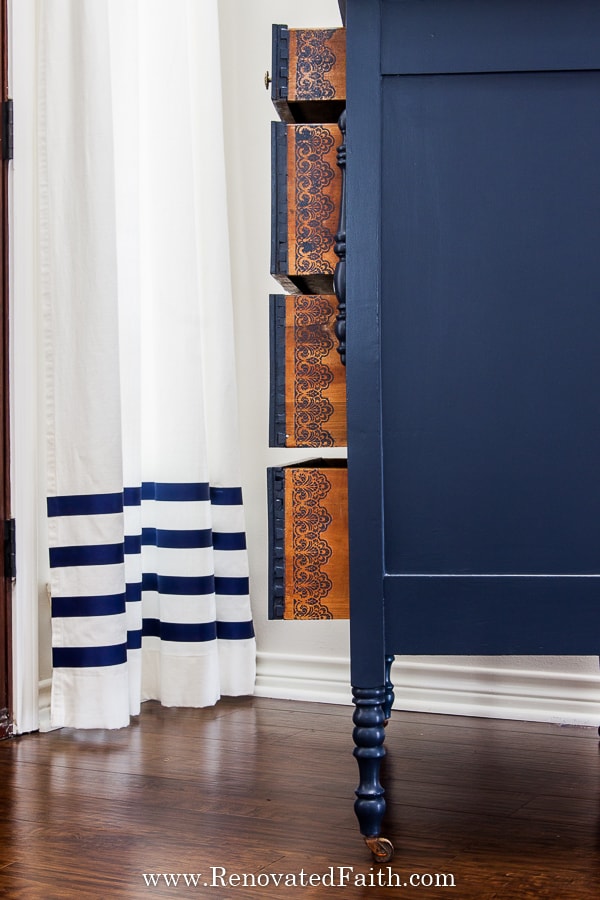
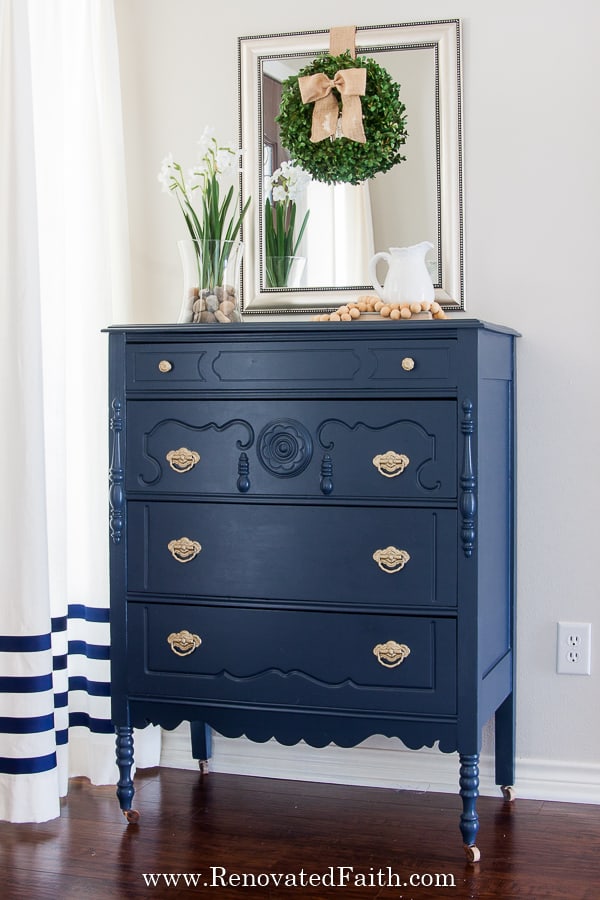
The Best Way to Paint With Stencils
I love the way the stencils turned out on my grandmother’s dresser. I especially like how they line up when all of the drawers are pulled out. It serves as such a sweet reminder of my grandmother and her love for sewing.
To read more about my grandmother and what she stood for, you can click here: Why You Struggle to Rest (And What to Do About It)
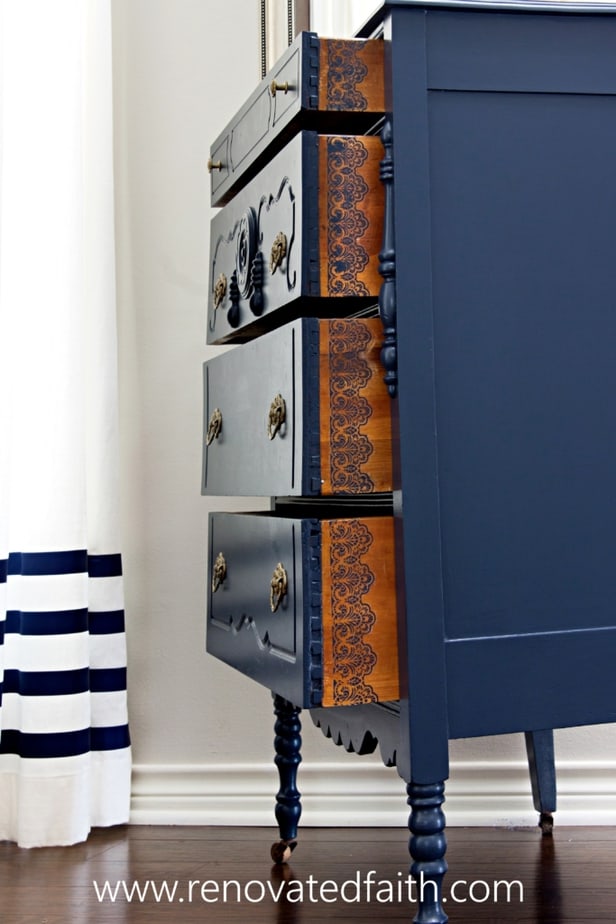
How to Stencil on Wood Signs
You can use the same process for wooden signs, whether the wood is painted or on raw wood. Remember to sand first or use a clear coat to fill any cracks in repurposed wood boards. Follow the same process in the tutorial above for any wood sign stencils.
Free Printable Stencils for Wood Signs
Here is how to make your own stencil for wood signs and this method doesn’t require paint at all! You can read the full step-by-step tutorial on how to make any wording stencil as well as an easy way to ensure there is no bleed-through. Download the free template and see the instructions here: How to Make Wood Signs The Easy Way

To see my best tips for painting with dark colors, click here: Benjamin Moore Hale Navy Dresser Makeover.
☑️ My All-Time Best Furniture Painting Tips & Tricks (FREE PRINTABLE)
Don’t forget to download the FREE step-by-step printable checklist that shows you the entire process I’ve used on dozens of furniture pieces while saving you time and money!
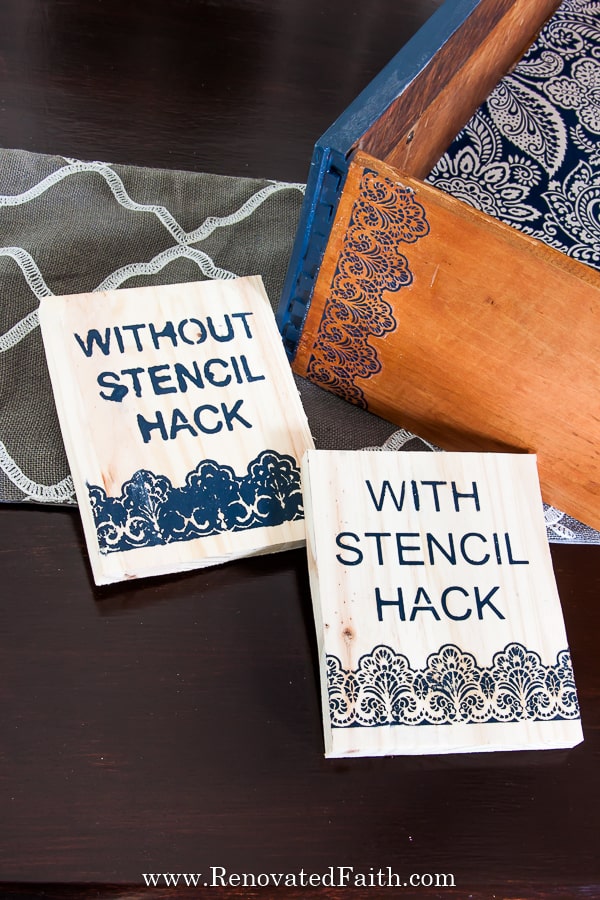
You can see how to make fabric drawer liners that are paper-like, scented, and stain-resistant here: The Easy Way to Make Fabric Drawer Liners
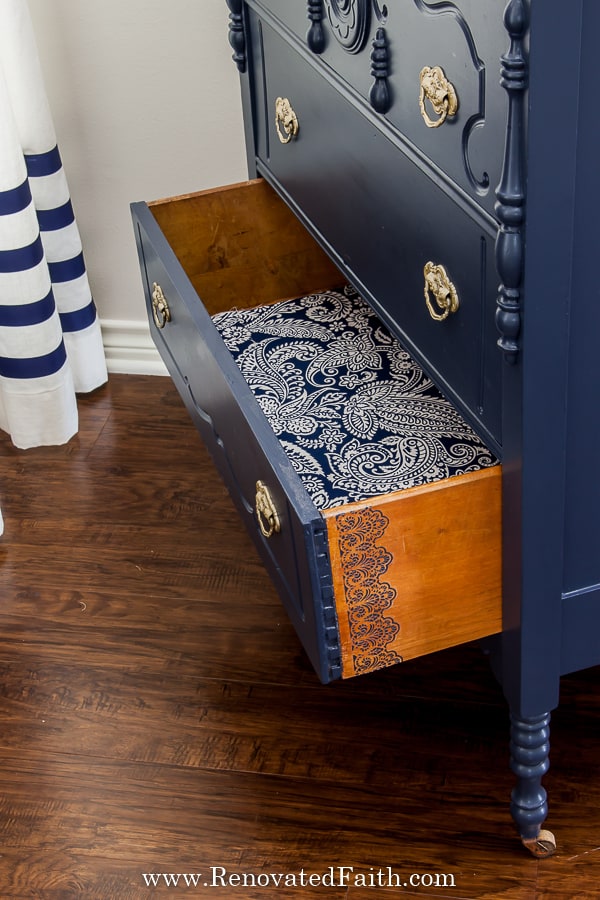
More Posts Related to The Best Way to Paint with Stencils
Benjamin Moore Hale Navy Dresser (Tips for Painting with Dark Colors)
DIY Fabric Drawer Liners that are Paper-Like, Scented & Stain-Resistant
Must-Have Tips for Painting Furniture
Why I Stopped Using Chalk Paint on Furniture
The Easiest Way To Turn Acrylic Paint Into Fabric Paint
Easy Christmas Front Porch Decor on A Budget
The Best Wood Grain Filler for Oak Cabinets
Easy Raw Wood Finish With Latex Paint
Easy Painted Wood Sign Tutorial (A Simple Technique Without A Cricut)
Easy DIY Closet Ideas for An Extra Office or Craft Room
FAQ: How Do You Get Clean Lines with Stenciling on Wood?
How To Stencil on wood with Chalk Paint
If you are wanting to use chalk paint for your stencil, be sure to use a good clear coat or wax on top of the stencil. As I described in my post, Why I Stopped Using Chalk Paint On Furniture, you will need to protect the chalk paint somehow. That’s especially the case if you are stenciling on a furniture piece that might get some wear and tear.
How to Stencil on Wood with Acrylic Paint
I happen to use latex paint with this project but 9 times out of 10 I use acrylic paint when stenciling. It’s actually a little easier to use acrylic paint when stenciling wood because it’s slightly thicker and less likely to bleed under the stencil edge. Still, make sure that a small amount of excess paint doesn’t settle on the inside edges of the stencil pattern. This will ensure you have smooth, crisp lines after your stencil paint dries.
To avoid this, use light coats of acrylic craft paint with your spouncer or foam brush. If you do get too much paint on the stencil, wipe extra paint off your brush and brush the edges of the stencil until there’s not much paint. Pull up the stencil after a few minutes and let the acrylic paint completely dry for a couple of hours.
How To Stencil on Wood Signs Without Bleeding
You can use this same blog post tutorial on DIY wood signs. I have had so much fun making my own wood signs with important Scripture verses and quotes using this technique: How To Make Your Own Wooden Signs (No Equipment Needed)
When it comes to making your own stencils, using a Silhouette Cameo or Cricut is a such an easy way to cut vinyl for stencil projects like painted wood signs. For beautiful signs without bleedthrough, be sure to add a clear cut to hard surfaces that have a lot of wood grain.
How To Get a Rustic Look With a Stencil
One of my favorite ways to get a rustic-aged look on stencils is with a dry brush technique. You can paint on your base color just like this tutorial details. Leave the stencil attached to the board and let it dry for at least an hour.
Then dab a brush in a little gray paint and use a paper towel or paper plate to wipe off most of the paint. Next, brush the gray onto the surface working consistently in the same direction. This will give you more of an aged, rustic look to make your sign look older.
How to Clean Stencils
Sometimes the mod podge and paint can dry on the back of your stencil but the good news is that you can use an old credit card (or a scraper like this) to remove it. Just let the stencil soak in warm water with dawn a few minutes to soften the paint and then scrape it off the stencil.
How to Stencil on Wood With Spray Paint
You can also use spray paint to stencil but know that the paint will probably permanently adhere to your vinyl stencil. Adhere the stencil to your surface, skip the mod podge step and spray paint your project outdoors. Make sure to cover all the rest of your project that you don’t want to be painted because spray paint can drift pretty far.
How to Stencil on Wood for Woodburning
When stenciling for woodburning, you will have to use a pencil to trace the inside of your stencil before using the wood burner. The woodburner can’t come in contact with the stencil because it will melt the stencil.
What is Better for Stenciling, a Brush or Sponge?
How Do You Attach a Stencil to Wood?
When making your own custom stencil, you can still make the back of the stencil sticky by spraying on Pixie Spray in a light coat. You can also use a large piece of transfer tape or print your design on contact paper before cutting it out.
How Do You Stencil On A Custom Design?
To make your own custom stencils, you have a few options. You can make a custom stencil design by uploading it into the Cricut software and using your Cricut cutting tool to cut the actual stencil. You can also use this method that doesn’t require any special equipment to make a special stenciled design: How To Make A Custom Stencil Easily For Your Own Wood Signs
Final Thoughts – What is the Best Way to Stencil on Wood?
With these tips, you can prevent paint from bleeding through your stencil, no matter how detailed! These hacks are super helpful especially when you are painting on uneven surfaces like Barnwood, repurposed wood, or vintage furniture. These tips on how to stencil wood will ensure your project turns out perfect every time!
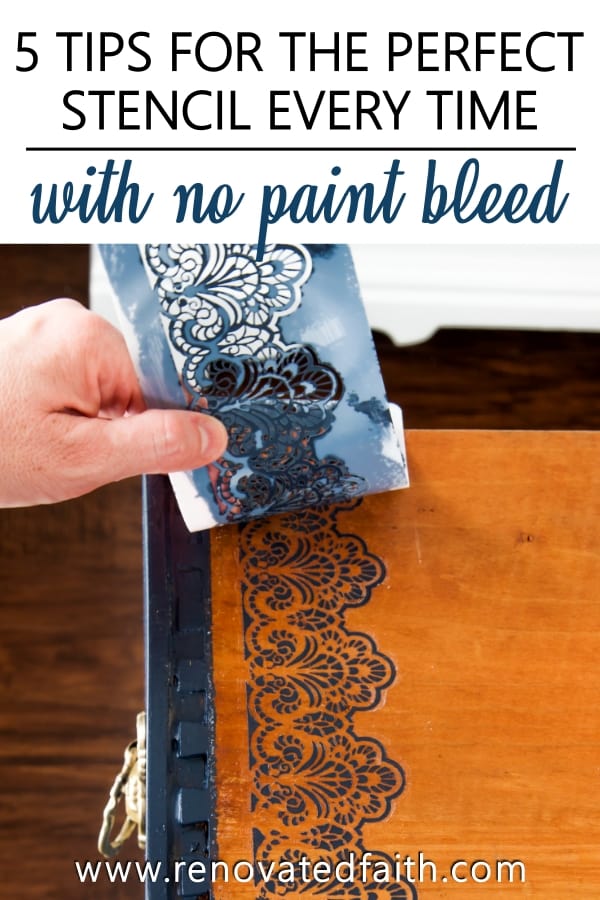
I love to hear your thoughts and questions! Scroll down to leave a comment and I WILL reply! ❤️
Blessings,

Be sure to follow the fun here!
Email Subscription | Instagram | Pinterest | Facebook | Twitter
How to Stencil on Wood, YouTube Video:
How to Stencil on Wood Without BLeeding

Karin Peters is a DIY expert and the creator of Renovated Faith. She is a furniture painter, a home design consultant, and a tenacious problem solver determined to help you transform your house into a home. With 17 years of experience with DIY home improvement, she researches and analyses professional processes to adapt them to be easy and cost-effective for DIYers. She then tests every project and product before it appears on the site in a detailed, step-by-step format. After attending Texas A&M University, she received her Master of Divinity with Biblical Languages at Southwestern Baptist Theology Seminary. Her passions unite in Renovated Faith, which shows readers how to create a home that serves them so they can pursue their God-given purposes. About Renovated Faith | Editorial Policy | Facebook | Twitter | LinkedIn



Hi Karin,
I love your blog! I’ve been reading it for a while, but this is the first time I’ve written with a question. I’m about to paint my bedroom doors and wood trim white. The current, natural woodwork (baseboards and around the doors) has never been painted. It is the original wood with a slight glossy varnish on it. Would I get better results if I sanded it first? I started to paint the baseboards behind the dressers after I painted the room (so I could move the furniture back) and it seems like it will take multiple coats to cover the darker wood. That’s when I thought about sanding.
I look forward to your reply!
Kim
Hey Kim, Thank you so much for your kind words! I so appreciate that. Go ahead and sand because I’ve had some paint peel on trim bc I didn’t sand. But just scuff sand enough to take off the sheen. Use Benjamin Moore Advance – it’s amazing in terms of coverage. Hope this helps! Thanks again Kim!
I have sanded the top of my kitchen table, it is oak, but had a lot of places on it. I want to just paint the top a shade of green, then stencil it. What do I do, and what do I seal it with, so as to keep using it as my kitchen table Thank you so much.
I don’t get the mod podge. I understand its purpose of sealing the edges of the stencils, but how does the paint then get through it once it’s dried? You seemed to paint it all over. When you paint, does the the paint somehow penetrate the mod podge. Maybe I’m missing something.
Also, is using spray paint after all the prep-work not recommended?
I’m trying to stencil my daughter’s name on a stool I built for her that’s already been painted.
Hey Roger, I had the same question as you. So, the mod podge gets painted on and fills that tiny horizontal space where the paint could potentially seep under the stencil. That’s the main function of it and it also covers the surface where the paint will go but just dries under the paint. I hope that makes sense. Also, I would think using spray paint instead of acrylic paint would be fine, I just haven’t done it. You might do a test on a sample board first just to be safe. Let me know if you have any others questions. Thanks! Blessings, Karin
How long is the wait after the stencil to do the top coat? My stencil turned out really well with the tips and I don’t want to mess it up now! 🙂
I’m so glad to hear it turned out ok! I would wait a couple hours just to be safe. Thanks Laura! – Blessings, Karin
So I painted a stencil with acrylic on top of a side table that I painted. Do I now use that top coat with the black square sponge that you recommend on top of the stencil to seal it?
Hey Laura, Yes, you can use the black foam brush to apply the clear coat. Don’t sand in between as the instructions might say. Apply 2 or 3 coats with 30 minutes at least of dry time in between and brush all in the same direction. Hope this helps!
When you brush the Mod Podge over the stencil, you said to let the Mod Podge dry before using your stenciling paint. How do get the Mod Podge off the stencil and doesn’t the dried Mod Podge make the stencil stick to the surface?
Thanks!
Hi Susano, It dries but not so much that you can’t get the stencil off. You can remove the mod podge when you are done using it with Dawn dish soap and hot water. Let it soak first and then you can use a sponge on what’s left. Thank you and let me know if you have any other questions! Blessings, Karin
Should I apply to coat after stencil is dry to protect the furniture? How many coats?
It definitely won’t hurt. I did the same on mine for extra insurance. Just follow the instructions on the back. Thanks Kim! Blessings, Karin
I am wanting to stain a piece of wood and then stencil over the stain. The stain is oil based and the paint is just the folk art paint.
Should I add sealer over the stained wood, let dry and then stencil it? I will use the mode podge as well
Hey Lori,
I don’t think you need to use a sealer because your stain is oil-based. Thanks Lori. – Karin
When you applied stencils to the side of your drawers, first you applied something to the entire surface. What was it? I’m ok with the spray adhesive and mod podge but I need to know what you put on first. Thank you. Your website is very helpful
Hi Gayle, Great question! I actually brushed on some clear topcoat (Varathane Waterbased Polyurethane). Here is the link: https://amzn.to/3nGFVyW.
It is an optional step but it just helps to fill in any cracks that might cause the plaint to bleed. Let me know if you have any questions! -Karin
Hi Karin, This is Diana again. I should have mentioned the box is made out of balsawood. Thank you.
Hi Karin, I am new to stenciling. I wanted to add a stencil to a keepsake box I purchased and had the company laser a poem on it that I composed. To add some interest to the top of the box, I purchased a DecoArt multi-purpose satin paint, sponge brush and stencil recommended by a Michaels employee and was told to tape down the stencil and then blot on the paint. There was no mention of using ModPodge. I did four stencils on each corner of the top of the box. Unfortunately, paint apparently bled under the stencil on one of them, and now you can’t see the fine details. How can I fix this or do I need to remove it and start over? I appreciate any suggestions you might provide. Stay safe and be well.
God bless, Diana 06-29-2020
I hate to say it but you might be easier to lightly sand off any built-up paint, recoat and do it again. The Mod Podge is super helpful for making sure the paint doesn’t seep underneath. Don’t worry! It’s happened to all of us at one point or another! Thanks Diana!
Thank you for the stencil post. Great info and instructions. Amazon says it can no longer stock the spray on adhesive brand you mentioned. Is there another brand you would recommend? Thanks!
It looks like it’s back now Sommer!
Hi – amazon says the repositionable spray (pixie spray) is out of stock and don’t know if/when will be available. Do you have any other recommendations? I don’t want to mess up my expensive fav stencils with gunk that won’t wash off! Thank you!!
It should be back in stock now Sommer! Let me know if it’s not.
Great article and video Karen! Love what you’re doing with your ministry here. I have a customer that wants to do stenciling on her wooden kitchen floor so I’m looking into things. Do you think this process would work in that situation? I would need to clear coat it at the end correct so it can take traffic? What do you think? Thanks!
I think it would work well on a floor as long as it was clear coated afterwards. Best of luck!
I am new to stenciling but am super excited to try. Do you wash off you stencil completely between every use? I have a stencil with a reoccurring pattern that I will have to use about 20 times, I am starting to rethink my design. How long does it typically take you to paint one stencil?
Hi Bonnie,
I washed mine off after each use. If they aren’t too expensive, get multiples of the same stencil so you don’t have to stop as much. The painting part only took a minute or two. Thanks for stopping by and let me know if I can answer any more questions.
Karin
I have always been afraid every time I stencil, so I only do it when a piece begs for it! This is such a plethora of good information. Thanks so much for sharing your knowledge!
Love your work! I was looking at the stencil tips .. I don’t mean to be stupid but why do you use the mode Podge?
Great question and I probably need to explain this in the post. The mod podge creates a barrier between the edges of the stencil and the paint and since it dries completely clear you can’t see it. It just keeps paint from seeping under the stencil. Thanks and let me know if you have any other questions!
So just to be clear, you are painting the top of the stencil with Mod Podge and then you paint over the dried Mod Podge with your stencil paint.
yes, that’s exactly right!
I followed your instructions for a big porch sign project and it came out beautiful!!
I am SO happy to hear that Yvonne! Thank you for taking the time to share.
Thanks so much for the tips.
I love stacked deconstructed books which use rubber stamps to put stamped words on the book spines. This should be a quick and easy project. Theoretically you remove the cover of paperback books OR paint the cover of hardback books then stamp.
I am using wood block stamps for the letters and can’t get the words to be anywhere close to looking good. Was about to buy clear rubber stamps when I read your article.
I have a Silhouette Portrait. Think I will try making stencils of my words. Maybe I can make my stenciling look like I stamped. It is worth a try.
Thanks for the idea.
That sounds like a great idea! I would love to see how it turns out. I just had someone on Etsy make a stencil for me. Let me know if you want their shop name!
Oh my ! So so beautiful! I used to stencil my curtains, etc. and have forgotten how nice it looks. But..the wood drawers! Very nice!
Thank you so much Mary! I really appreciate it. Have a great day!